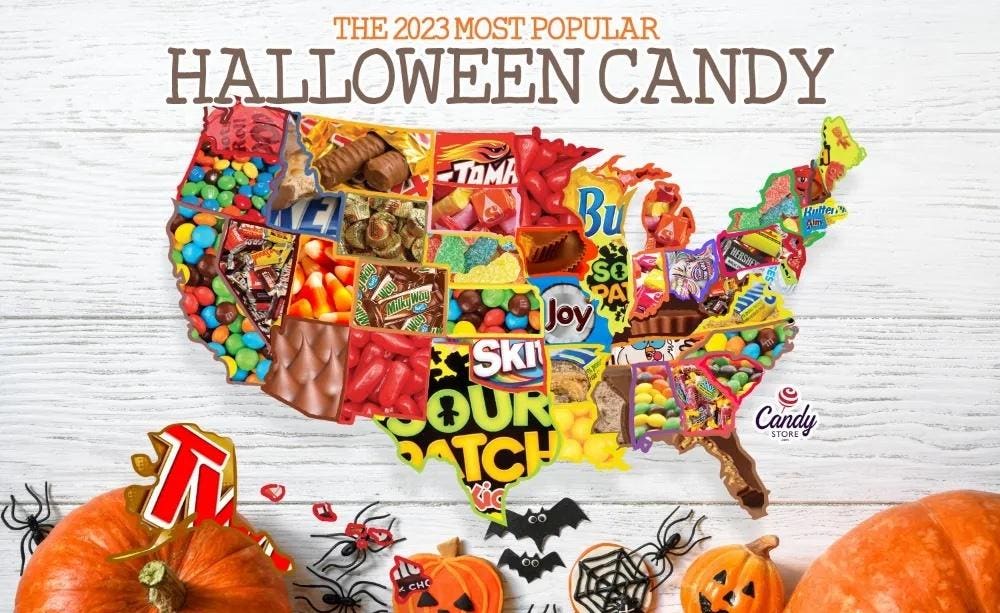Halloween candy and trick or treating are traditions heralded around the world, but this beloved tradition comes with a less than sweet environmental costs. Halloween has its origins in an ancient Celtic festival called Samhain (a Gaelic word pronounced “SAH-win”), according to the Library of Congress. It was meant to welcome the harvest at the end of summer. People would light torches to ward off ghosts and bad vibes. The origins of trick-or-treating and devouring candy are a bit less clear, but historians believe it is connected to traditions of leaving offerings to appease spirits.
From A Spooky Vibe To A Billion Dollar Industry
That tradition of warding off bad spirits and keeping vibrations high has since evolved into big business. The National Retail Federation expects Halloween 2023 to reach $3.6 billion in sales. About 172 million Americans celebrate the holiday in some way. As noted in the map above, each state has a favorite candy brand to tempt trick-or-treaters.
Candy And Food Waste: The Case For Conservation
Besides the centuries-old debate between parents and children about the consumption of Halloween candy, there is also a sustainability concern. First is the issue of materials waste. Individual candies come in wrappers that are difficult to recycle, a vestige of ’70s-era tampering scares. Next, there are concerns about the amount of food waste that happens on Halloween. The World Economic Forum claims that discarded pumpkins alone account for 18,000 tons of food waste, and more than $400 million of uneaten candy gets tossed every year.
The Dark Side Of Halloween Candy Production: Environmental Damage And Harmful Chemicals
Consumer advocates claim that Halloween candy production has a dark side in that still uses controversial ingredients like Red Dye No.3 and titanium dioxide. Both are at issue in recent lawsuits about the health impacts of these chemicals. The Sierra Club and the National Wildlife Federation raise other startling concerns, such as the use of palm oil, an ingredient in Halloween candy as well as about half of all grocery products. Rainforests in Asia and the Amazon are burned to make way for palm oil plantations, which contributes to air pollution and the destruction of animal habitats.
Candy Corn Is Always Controversial, But What’s In It?
Candy corn is consistently divided into teams “love it” or “hate it,” and this writer is solidly in the latter camp, given its contents. “Candy corn is classified as a mallow cream. Its ingredients are sugar, corn syrup, confectioner’s glaze (shellac), salt, dextrose, gelatin, sesame oil, artificial flavor, honey, and colors,” explained Rich Hartell, editor-in-chief of the Institute of Food Scientists’ Journal of Food Science. Depending on the manufacturer, those colors are the aforementioned red dye that was banned in California. Hartell also confirmed the reports of candy corn being made from insects. The shellac that gives the confection its shiny gloss comes from the secretions of the lac bug. This is purified for human consumption. This ingredient is used to make malted milk balls and other coated confections.
Shift To Sustainability?
There is a shift toward sustainable candy options: organic ingredients, eco-friendly packaging and even sweet innovations. Nestle recently announced it will remove all artificial coloring and flavoring from its candies all year round. Other producers are making changes such as reducing the amount of packaging used and transitioning to biodegradable materials.
Sustainable Treats And This Halloween
Until these changes take effect, here are some ways to make this Halloween more sustainable. As a counterbalance to its warnings about Halloween candy and palm oil, the Sierra Club offers a list of candies it considers sustainable. The Yoga Journal also created a list of eco-friendly candies, including items that use compostable packaging, skip the palm oil or are fair trade. You can also be sustainable by reading labels and swapping Halloween candy for other treats, like homemade cookies. While there is guidance about how to find sustainable and eco-friendly candy, unfortunately, none of these lists can help you figure out which neighbor has the proverbial “good candy.” Happy Halloween!
Read the full article here





